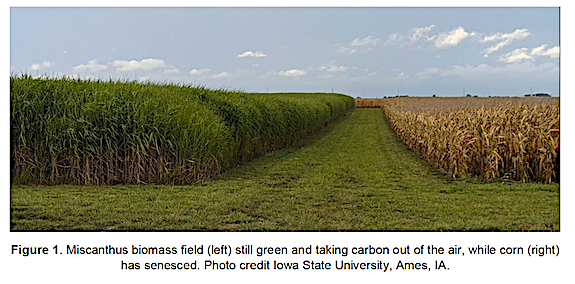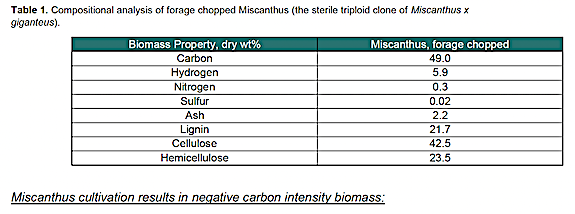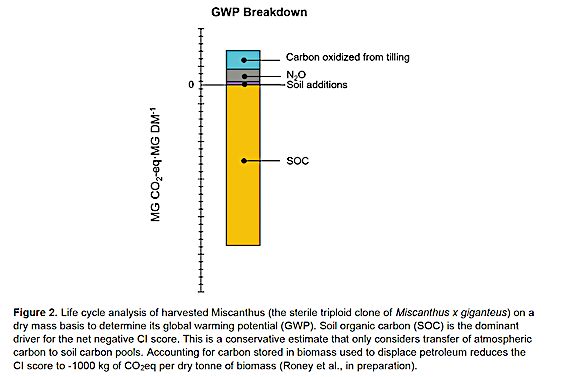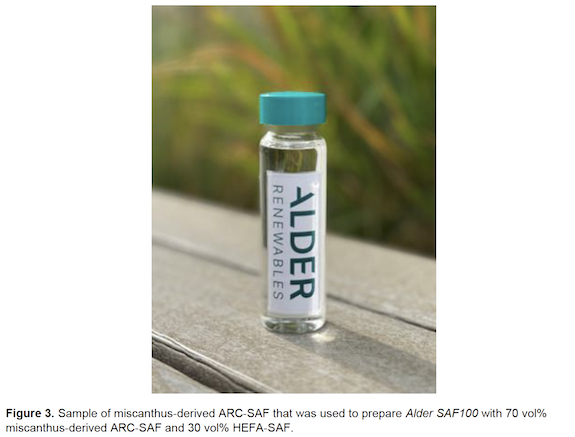Alder Renewables unlocks carbon-negative SAF via miscanthus breakthrough
 By Tim Obitts, CEO & Dr. Derek Vardon, CTO, Alder Renewables
By Tim Obitts, CEO & Dr. Derek Vardon, CTO, Alder Renewables
Special to The Digest
Tl;dr:
- Sustainable aviation fuel (SAF) produced from miscanthus Alder Renewable Crude (ARC) can reduce greenhouse gas emissions by 110% compared to conventional fossil jet fuel.*
- A purpose-grown energy crop, miscanthus can store roughly half of the carbon it removes from the air below ground. It builds extensive root and microbial systems that enrich soil, reduce water and soil runoff, and improve nutrient retention.
- Therefore, SAF produced from miscanthus has the potential for being carbon negative, without the need for additional CO2 capture technology.
- Alder Renewables was awarded a research and development cooperative agreement by the Department of Energy’s Bioenergy Technologies Office to evaluate the potential of miscanthus to produce carbon-negative sustainable fuels with ARC.
- In our testing and analysis process detailed below, miscanthus-derived Alder SAF100 scored impressively across all major fuel property indices. Life cycle analysis confirmed its carbon negative potential.
*Estimated GHG emissions for miscanthus-derived ARC-SAF are based on a life cycle carbon intensity analysis that includes soil organic carbon accumulation from biomass cultivation and refining ARC with low carbon intensity hydrogen.
Introduction
The proprietary technology we have created at Alder Renewables is built upon a single, immutable foundation: biomass. In effect, our value proposition as a company with a decarbonization mission is inextricably tied to our ability to process biomass efficiently— effectively and at scale. By applying our proprietary process to upgrade traditional fast pyrolysis oils, our technology can convert solid biomass–sustainably sourced and accredited–into Alder Renewable Crude (ARC).
To fully realize the potential of ARC, we primarily rely upon the availability of abundant biomass, like agricultural residues, sustainably sourced wood waste products, and purpose-grown energy crops. Therefore, for the downstream renewable products ARC unleashes to be truly sustainable, like sustainable aviation fuel (SAF) for example, they
must reduce greenhouse gas emissions over the lifecycle of the fuel production, e.g., from development to end-use. This journey all starts with the biomass itself, which is why we are pursuing multiple feedstocks to lay a broad foundation for ARC technology commercialization.
The Carbon Intensity (CI) score of the biomass directly affects the end-use products that ARC can unleash. This sounds simple, but it has often been confused in debates around what is truly “sustainable.” For example, SAF that utilizes corn ethanol or soybean oil can result in significantly less CI savings than biofuels produced from waste products, such as SAF produced from agricultural residues, or HEFA-SAF produced from hydroprocessing used cooking oil (ICAO 2021). Furthermore, depending on how farmland to produce crops is managed, over-tilling can degrade soil health and organic carbon stock. Also, frequent fertilizer application increases net greenhouse gas emissions and negatively impacts water resources due to runoff. Although downstream carbon capture and sequestration technologies can further lower the carbon intensity of both food-derived and waste derived biofuels, the important takeaway is biomass–and the carbon reduction potential therein–is not created equally.
For example, ARC-SAF produced from woody biomass residues results in biofuel with up to 80% lower greenhouse gas emissions than fossil jet fuel without CO2 capture technologies, like direct air capture or underground geological storage. This equates to a carbon dioxide equivalent (CO2e) value for ARC-SAF of less than 18 g CO2e/MJ, relative to fossil jet fuel at 89 gCO2e/MJ (ICAO 2021). This is a scalable, sustainable non-food pathway to SAF that is demonstrably showing great promise.
However, to explore the potential of advancing these CI scores further–perhaps even reaching the coveted net carbon negative threshold–we must assess new, purpose-grown biomass feedstocks that improve soil health and increase soil organic carbon stock. The increase in soil organic carbon provides an agricultural-based route to negative carbon intensity biofuels (ICAO 2021), without the need for additional CO2 capture technologies.
The industry is also forced to contend with a potentially more profound question: what would our energy and agricultural sectors look like with broad deployment of purpose- grown energy crops? For example, shifting the paradigm around land use to drive a low-carbon fuel production cycle can have a seismic (and lasting) impact on our societal decarbonization and agricultural strategies. Cross-sector integration is key.
Miscanthus & Regenerative Agriculture: The Early Promise & Potential
These themes have animated our testing and development efforts at Alder Renewables as we move towards commercialization. The primary reason we have been so focused on developing proprietary and adaptive pyrolysis-based technology is scalability, but it is also biomass diversification and land-use considerations. We want to harness a range of biomass feedstocks that span the spectrum from residues to purpose-grown energy crops—rather than just one or two distinct input use cases. Most importantly, we want to
advance wide technical and commercial readiness, and to drive a thoughtful conversation around the divergent spectrums of what constitutes “renewable” and “sustainable.”
With concerns over climate change and fossil fuel use, work has accelerated to develop non-invasive, non-food crops, that have potential to favorably impact our renewable fuel supply chains and agricultural systems. These so-called “perennial” crops include Miscanthus (the sterile triploid clone of Miscanthus x giganteus) [Heaton et al. 2008].
Miscanthus has a unique growth behavior of interest to Alder Renewables, namely its ability to store roughly half of the carbon it removes from the air below ground, building extensive root and microbial systems that enrich soil. These systems reduce water and soil runoff, while improving nutrient retention. More specifically, miscanthus cultivation significantly increases the soil organic carbon when compared to the soil’s native state: for every ton of miscanthus biomass that is harvested, another ton is put below ground in roots and nutrient storage structures where it is not easily returned to the atmosphere.
Instead, carbon stored underground cycles slowly through roots and microorganisms, improving soil health and nutrient cycling. This means fertilization needs are negligible, thereby saving further greenhouse gas emissions. Once established, miscanthus is not tilled or irrigated, and is minimally fertilized, facilitating a virtuous circle that could–if appropriately harnessed and managed–be powerful in the process of decarbonizing difficult to abate fuels, like aviation [Uludere Aragon et al. 2023] and marine.
Therefore, extensively investigating the potential of purpose grown energy crops–like miscanthus–could be pivotal. Not only for providing feedstock for biofuel production, but also for reducing atmospheric CO2 levels, while improving soil quality and health. Most importantly, analyzing miscanthus thoroughly can spark an important conversation around the structure and strategies of our current energy and land use paradigm.
Dr. Emily Heaton, Director of Illinois Regenerative Agriculture Initiative, UIUC, commented:
“Perennial prairie pulled atmospheric carbon into Midwestern soils for millennia, helping to make them a fertile part of the largest terrestrial sink of carbon on the planet. Extractive agricultural practices have released approximately half of that carbon back to the atmosphere while polluting our waters and reducing the food system’s resilience to climate change. Perennial dedicated energy crops like miscanthus provide a disproportionate benefit to our ecosystem and society: because they are so productive, they require little land yet keep 70-100% of nutrients and soil in our fields compared to today’s corn/soy system [Heaton 2008; Schulte et al. 2017; Studt et al. 2021]. When strategically placed around and between corn/soy fields, miscanthus improves the carbon balance and function of the entire agroecosystem, far beyond climate benefits from fossil fuel displacement.
Miscanthus is an early part of a portfolio of permaculture cropping systems we are developing for resilient bioeconomies. It is commercially available and deployable today, with thousands of acres planted across 12 states. It is profitably used in diverse bioenergy and bioproducts supply chains (for example, animal bedding, compostable containers, heat, and power) and paves the way for broader use of diverse, regionally adapted perennial crops. That profit depends in part, however, on robust, transparent understanding of the carbon footprint within a given supply chain.
Because there is a critical need for agreed-upon frameworks for carbon intensity assessment that use site-specific data within discrete components of the supply chain, we continually measure soil, microbial, plant, and atmospheric carbon fluxes within miscanthus fields around the region, throughout the entire year. These data are transparently published and publicly available to enable consistent, accurate CI assessment by Alder Renewables and the entire sector.”
Partnership for Miscanthus R&D
Alongside our partners, Alder Renewables was awarded a research and development cooperative agreement by the Department of Energy’s Bioenergy Technologies Office to evaluate the potential of miscanthus on its journey: starting at the field, to conversion to ARC, and finally refinement into renewable transportation fuels, including SAF.
Miscanthus (the sterile triploid clone of Miscanthus x giganteus) was grown and harvested by AGgrow Tech, a private company commercializing U.S. miscanthus production that has opened its fields to public researchers since 2013. Cultivation and harvest data were also generated through independent field trials in Illinois and Iowa, respectively. The University of Illinois Urbana-Champaign (UIUC) developed the carbon intensity analysis framework, along with field experiments and modelling, to provide a credible means of verifying the CI values of the aggregated miscanthus.

Once the miscanthus was harvested, it was preprocessed at Idaho National Lab’s Biomass Feedstock National User Facility. BTG Bioliquids, a commercial fast pyrolysis technology provider, performed fast pyrolysis in their pilot plant with more than a ton of miscanthus. The fast pyrolysis oil was then upgraded into ARC using our proprietary technology at the National Renewable Energy Laboratory (NREL) in Colorado, before scaling miscanthus ARC production at a tolling partner facility.
Miscanthus ARC was then refined into liquid hydrocarbon fuels with support by our commercial technology partner, Honeywell UOP. Experimental yields and material inputs for converting miscanthus into finished fuels were used for a preliminary field-to-fuel life-cycle analysis with NREL. Finally, SAF fuel property testing was completed by Harrison Yang and Dr. Joshua Heyne at Washington State University (WSU). This production cycle, in effect, provided a field-to-fuel demonstration of Alder Renewables’ proprietary ARC technology with miscanthus.
Key Results:
Miscanthus is well-suited for fast pyrolysis:
- Miscanthus was forage chopped directly from the field to provide biomass material free of ground contaminants.
- Harvested miscanthus displayed a relatively low ash content and moderate lignin content relative to agricultural feedstocks, such as corn stover and switchgrass [Howe 2015].
- Low ash content typically correlates with higher fast pyrolysis oil yields and less inorganic impurities [Pienihäkkinen 2022].
- High lignin content typically correlates with finished liquid hydrocarbon fuels that contain increased levels of energy-dense, cyclic hydrocarbons desirable for SAF [Kramer 2022].

Miscanthus cultivation results in negative carbon intensity biomass:
- The UIUC team determined that miscanthus cultivation and harvesting can result in a significantly negative net CI score for the biomass itself (below -300 kg of CO2eq per dry tonne of biomass, see Figure 2) based on their field data and peer-reviewed scientific literature.
- The negative biomass CI score for miscanthus, reported in million grams of CO2eq per million grams of biomass dry matter, is driven by the significant increase in soil organic carbon as the crop grows. This offsets the initial tilling of miscanthus (only required 1 to 1.5 times, depending on establishment method), fertilizer use, and N2O emissions associated with miscanthus cultivation.

Miscanthus ARC:
- Miscanthus fast pyrolysis oil was converted into ARC with similar C-yields as ARC produced from woody biomass residues.
- Miscanthus ARC was near water free (<1 wt%) with total metals below 100 mg/kg.
- Hydrotreating miscanthus ARC produced a liquid hydrocarbon product with an oxygen content below detection limits (<0.05 wt%).
Carbon negative, Alder SAF100 with miscanthus
- When accounting for the miscanthus biomass CI, as well as material and energy inputs for producing ARC and refining it into liquid hydrocarbon fuels with low CI hydrogen, the net CI score of miscanthus-derived ARC-SAF is below 9 gCO2e/MJ. This is within the range of CORSIA default total life cycle emissions values for miscanthus-derived SAF (-11 to -23 gCO2e/MJ) produced with other emerging technologies [ICAO 2021].
- Blending 70 vol% miscanthus-derived ARC-SAF into HEFA-SAF produces Alder SAF100 with a higher density, higher energy density, and lower freezing point relative to neat HEFA-SAF.
- Aromatics are present at 18.8 vol%, which results in “drop-in” polymer compatibility with today’s aircraft fleet [Kramer 2022].
- The negative CI potential, relative to conventional fossil jet fuel, still holds when making Alder SAF100 with blends of miscanthus-derived ARC-SAF and HEFA-SAF from low CI routes at the ratio tested above.



Dr. Joshua Heyne, Director of the Bioproducts, Sciences, and Engineering Lab, WSU, commented:
“Prescreening novel SAF candidates expedites platform development by providing staged evaluation criteria, which lowers volume requirements and costs. We aim to meet producers where they are in their product development with the appropriate tests at the lowest volumes possible.
The prescreening results of miscanthus-derived Alder SAF100 exhibit a good prescreening result. The properties important for combustor operability are all within the desired specification ranges. Plus, the sample contained compositions compatible with our experience for 100% SAF, aromatics (18.8 vol%) with appreciative concentrations of cycloalkanes, which could also complement other commercialized SAF technologies.“
Conclusion
Miscanthus-derived Alder SAF100 scored impressively across all major jet fuel property indices. Critically, life cycle analysis determined this fuel has potential for being carbon negative, relative to conventional fossil jet fuel, without the need for additional CO2 capture technology. We believe this research represents a tangible step towards unlocking carbon negative fuel production at scale and advancing the conversation around regenerative agriculture to mitigate the worst effects of climate change.
This research also reemphasizes the critical point that all biomass is not created equally. As such, the benefits to soil quality and carbon intensity scores of the starting biomass feedstock must be front and center, particularly as the industry identifies scalable pathways to maximize decarbonization impacts from a variety of biomass feedstocks.
In the absence of electrification and viable battery-powered technologies, fostering purpose-grown biomass feedstocks and new biofuels conversion technologies will be increasingly critical. Most importantly, we must engage in a more pressing and transparent conversation around optimal land use for energy production to realize the goal of rapid decarbonization.
References:
- ICAO. CORSIA Default Life Cycle Emissions Values for CORSIA Eligible Fuels. (2021).
- Heaton, E. A., Dohleman, F. G. & Long, S. P. Meeting US biofuel goals with less land: the potential of Miscanthus. Global Change Biology 14, 2000–2014 (2008).
- Uludere Aragon, N. Z. et al. Sustainable land use and viability of biojet fuels. Nat Sustain 1–11 (2022) doi:10.1038/s41893-022-00990-w.
- Schulte, L. A. et al. Prairie strips improve biodiversity and the delivery of multiple ecosystem services from corn–soybean croplands. Proceedings of the National Academy of Sciences 114, 11247–11252 (2017).
- Studt, J. E. et al. Soil net nitrogen mineralization and leaching under Miscanthus × giganteus and Zea mays. GCB Bioenergy 13, 1545–1560 (2021).
- Howe, D. et al. Field-to-Fuel Performance Testing of Lignocellulosic Feedstocks: An Integrated Study of the Fast Pyrolysis–Hydrotreating Pathway. Energy Fuels 29, 3188–3197 (2015).
- Pienihäkkinen, E., Lindfors, C., Ohra-aho, T. & Oasmaa, A. Improving Fast Pyrolysis Bio-Oil Yield and Quality by Alkali Removal from Feedstock. Energy Fuels 36, 3654–3664 (2022).
- Heyne, J., Rauch, B., Le Clercq, P. & Colket, M. Sustainable aviation fuel prescreening tools and procedures. Fuel 290, 120004 (2021).
- Kramer, S. et al. Perspectives on Fully Synthesized Sustainable Aviation Fuels: Direction and Opportunities. Frontiers in Energy Research 9, (2022).
Category: Top Stories















